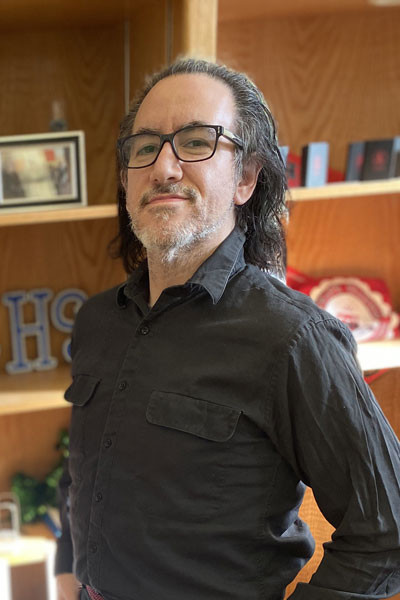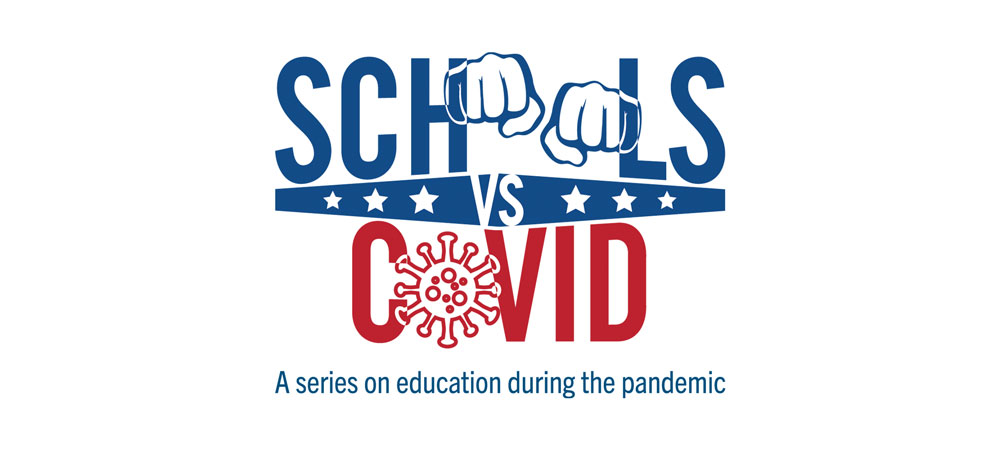When it comes to planning how to bring students back to campus this fall, most of America’s 90,850 public school principals are, at best, making educated guesses.
Brett Schneider, Principal of Bronx Collaborative High School and a member of the 2019-20 cohort of Teachers College’s Cahn Fellows Program for Distinguished Principals, is drawing on first-hand experience.
In late March, as New York City’s schools went remote, Bronx Collaborative was designated a Regional Enrichment Center (REC), charged with serving children of health care providers, transit workers, and other first responders to the COVID pandemic.

IN CONSTANT CONVERSATION Schneider believes school leaders must stay in constant dialogue with their communities during the pandemic. (Photo: TC Archives)
Schneider, who founded Bronx Collaborative in 2013 with the motto “Solve a problem. Change the world!”, was put in charge. And under his direction, the center did not record a single instance of coronavirus infection.
[Read a story in The Morning Bell, a publication for New York City students, parents and educators, about Schneider’s REC leadership.]
That success is a major reason why 70 percent of Bronx Collaborative parents (far above the citywide average) want the school to offer on-campus classes this fall.
Not that Schneider is cocky — far from it. “People are scared, and with good reason,” he says. “But I can’t operate from a place of fear.”
Accordingly, he’s working with a faculty team who put forward several bold plans for reopening that differs significantly from what many other schools have proposed. (On August 7th, New York State Governor Andrew Cuomo announced that schools could physically reopen provided that local district infection rates are under 5 percent.)
One proposal is that each of Bronx Collaborative’s four grades will be divided in half — so, for example, tenth-graders will become either “Avengers” or “Justice Leaguers,” each with a dedicated set of teachers, and they’ll alternate coming to school in two-day shifts. Each group will take only four courses — but, aided by the use of double periods, the courses will cover a year’s worth of material in a single semester.
“So, let’s say the Avengers take all of English 1, art, biology and foreign language during the first semester, while the Justice Leaguers complete a full year of math, social studies, music and a different science,” Schneider says. “That supports our school’s focus on project-based work — we’re all about depth rather than breadth — and it also creates more ability to go fully online if infections rise, because everyone will be deeply immersed in the work from the get-go.”
While the amount of actual face time with teachers will be only half of what students would get in a normal semester, it will still exceed what most other schools are proposing while involving less classroom rotation and other moving pieces. One of their other innovation proposals include a grade-wide interdisciplinary course co-taught by all face-to-face teachers on the grade in a block schedule; this would balance out those educators who are only available remotely as well as limit transitions. Faculty focus groups are paired with parent and student leader meetings to make final proposals for city and state approval under their innovation proposal model.
People are scared, and with good reason. But I can’t operate from a place of fear.
—Brett Schneider
Schneider does not claim to be an expert on all the different issues that the pandemic has pushed to the forefront. For example, he’s quick to acknowledge that at his school, where 92 percent of the students are sufficiently poor to qualify for for free or reduced-price lunch, the switch over to digital learning was “a heavy lift.”
“I earned my master’s and doctoral degrees in education technology, but before the pandemic, our students were not at a point of looking online every day for their assignments,” he says. “Our philosophy for how to engage students is ‘read, write, walk, talk,’ meaning, do close readings and iterative writing, hold good conversations, and do meaningful kinesthetic activities, like walking the neighborhood to assess the local improvement plan. We handed out 250 laptops, but early on this spring, many of our kids were still writing papers on their cell phones.”
But at a school where the student body is 65 percent Latinx and 25-30 percent African-Caribbean (a category that the Bronx Collaborative community prefers to the more “colorist” designations of the National Census), Schneider — a fourth-generation educator and former social worker — can boast about leading a school community that has been in constant conversation. The topics have not only been COVID-related, but also, since the killing of George Floyd by Minneapolis police in May, about issues of racial and educational equity. Those dialogues build on Schneider’s founding vision for Bronx Collaborative of “decolonizing education” by fighting “the colonial mindset that dares to treat people as objects to control, abuse, and manipulate.”
“We opened in 2013 and have since worked with the Morningside Center for Teaching Social Responsibility to do restorative justice work,” he says “We do community circle discussions, we have curricula that help build social and emotional skills.”
And since Juneteenth, when Schneider sent a letter to parents, faculty, students and alumni affirming his own opposition to “white supremacy, in all forms” and pledging to continue using his “personal privilege” to amplify “the great voices in the movements led by people of color,” the school has held daily on-line meetings, open to all, on racial inequity.
[Read Schneider’s Juneteenth letter to the Bronx Collaborative High School community.]
“These are collaborative sessions, modeled after the Harlem Renaissance Salons, and they’ve led to some very rich discussions,” he says. “Faculty have become more comfortable with the challenges of discussing race. In the past, many would never have talked about those issues in a big meeting, but now it’s a daily thing. And we’ve made some real headway in thinking about how to bring students into greater empowerment this fall — for example, by establishing local chapters of Black Lives Matter and Amnesty International.” Schneider also credits “the Collaborative,” the school’s daily salon, with supporting next level discussions that challenge binary notions — embracing the need for the school to have conversations about Afro-Latinidad as representative for the school.
The school was created on very democratic principles. But sometimes people want a rulebook instead of having to build things from scratch.
Schneider brings one other asset to his work that he says has been invaluable during the pandemic: the support he’s received as a Teachers College Cahn Fellow.
The Cahn Fellows are top principals from cities around the nation (New York, Chicago, Miami, Atlanta, Dallas, Charlotte-Mecklenburg and others) who, while remaining in their jobs, spend 15 months working on special projects to improve their leadership and their institutions. They meet periodically on TC’s campus to work with the College’s faculty in Education Leadership and one another.
Schneider’s project has focused on “Ways of Knowing,” a concept developed by Cahn Fellows faculty member Ellie Drago Severson, Professor of Education and Director of TC’s Ph.D. Program in Education Leadership. Working closely with Drago-Severson, Schneider has sought to understand the different kinds of direction that his teachers and other staff members need from him and increase his own flexibility as a leader. One of his takeaways has been to be more assertive, particularly during the current crisis, in setting basic parameters — an insight also comes at a critical moment in the school’s evolution. The pandemic has allowed Schneider to step back and realize that the tiny school that opened with nine staff members and 90 students is now a midsize institution with nearly 70 staff members and 600 students.
“The school was created on very democratic principles, he says. “But sometimes people want a rulebook instead of having to build things from scratch. Our academic departments can be a lot more effective if they don’t get mired in debating basic philosophic approaches that, in fact, the school really does have a stance on.”
That said, Schneider believes that, whatever happens, principals must remain in constant dialogue with their school communities this fall.
“Having tons of discussions with lots of people is super helpful,” he says. “If an idea comes up in conversation with one group of people, raise it again with the next group. Keep cross-pollenating, because that’s how solutions get adapted to your school, and that’s how you get buy-in.”
He also counsels staying on top of the latest information about the pandemic and COVID prevention. “People are going to listen if you really know what you’re talking about. Someone may challenge the need to wear masks, for example — well, no. The jury really isn’t out on that anymore.”
But Schneider believes that perhaps the greatest challenge for principals, given the uncertainty surrounding the year ahead, is to think simultaneously about both “the long- and short-term — the macro and the micro.”
As an example, he points to planning for new student orientation later this month at Bronx Collaborative.
“Normally we’d bring in our ninth graders in for a four-day bridge, but we’re going to have to do that virtually. That’s big logistical challenge that we’ve got to figure out very quickly — and we may do it for the tenth-graders, too, because this past year ended so abruptly for them.”
But the bigger issue that underlies that problem, he says, is how to ensure that the school can continue to provide group experiences during which students “form the kind of social and emotional connection that can only come from being and working together.”
“Every grade normally has a three-day, two-night trip out of the city, but that was canceled. We also had to hold graduation virtually — we did a four-hour ceremony with a testimonial about each student. How do we get back to doing these things in person?”
The school has a football field, and Schneider is hoping that some time this fall, he can bring the whole community together, with proper social distancing, to honor last year’s graduates and “hand them their diplomas at a true homecoming.”
You can hear the emotion in his voice when he talks about that possibility. Whether it will happen is still anyone’s guess — but, as any good principal knows, it’s never to early to start thinking things through.
